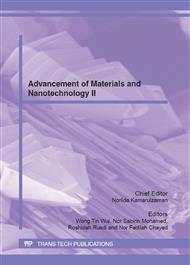p.50
p.59
p.64
p.71
p.76
p.81
p.88
p.93
p.100
Study of Iodine Influence in Synthesizing ZnO Nanoparticles via Precipitation of Zn – Ethanol Reaction
Abstract:
The morphology and physical properties of ZnO nanoparticles are greatly influenced by the way it is synthesized. In this work, we study the influence of iodine ion in Zn- Ethanol reaction as this ion is believes to have the ability to control the nucleation and growth of ZnO particles [1]. The morphology of ZnO particles in the presence of iodine shows nearly spherical in shape (size ~ 110 nm) whereas ZnO particles without the presence of iodine exhibit hollow microsphere with feeler like structure growth outward of the sphere . Photoluminescence (PL) spectra shows a broad UV emission peak for both of the sample where sample with the absence of iodine possess lower intensity of UV emission centered at 380 nm compared to samples with iodine which demonstrates stronger intensity at 390 nm despite of having very weak visible secondary emission peak at 530 nm. Iodine contribution to ZnO morphology, structural and optical properties was discussed where iodine has shown to have more controlled on the formation and nucleation of ZnO particles.
Info:
Periodical:
Pages:
76-80
Citation:
Online since:
July 2012
Authors:
Keywords:
Price:
Сopyright:
© 2012 Trans Tech Publications Ltd. All Rights Reserved
Share:
Citation:


